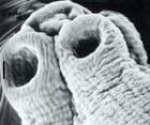NEIHPID
North-East India Helminth Parasite Information Database
Recently added
Parasites
Molecular Data
Baerietta baeri (Hsü Hsü)
Taxonomy
Platyhelminthes »
CESTODA »
Cyclophyllidea »
Nematotaeniidae Lühe, 1910 »
Baerietta Hsu, 1935 »
Baerietta baeri, Hsü 1935
Host
Euphlyctis (cyanophlyctis), Hyla (annectans), Limnonectes (limnocharis), Philautus ( sp.), Philautus (annandallii), Polypedates (taraiensis), Rhacophorus (bipunctatus(=R. reinwardtii)), Rhacophorus (maximus (=R. nigropalmatus))
Habitat
Intestine
Locality
Shillong (Meghalaya), Mawsynram (Meghalaya), Cherrapunjee (Meghalaya), Kohima (Nagaland), Mokokchung (Nagaland)
Description
Worms elongated, approximately 10.5 mm in length cylindrical, becoming gradually narrow towards posterior end; maximum width of body 0.24 mm anteriorly , 0.17 mm in posterior region; major length externally un-segmented; segmentation visible behind anterior three-fourth of body length where par-uterine organs start developing; earlier segments broader than long, later segments becoming gradually longer and narrower; posterior segments longest, clearly demarcated. Scolex unarmed, non-bothridiate, non-rostellate, with four simple suckers, passing into long neck. Genital rudiments start differentiating behind neck; segmentally arranged as dark, narrow transverse streaks, later becoming broader, more compact in succeeding segments. Genital pores in mature segments alternately arranged, as clear from irregularly alternate segmental position of genital rudiments. Mature segments externally un-segmented, but internal segmentation visible, wherein they are broader than long. Testes two per segment, dorsally placed, spherical to sub spherical, composing of loosely arranged large, spherical bodies, as seen in cross section. Cirrus pouch, as seen in cross section, short, broad, more or less flask shaped with short, narrow neck. Genital pores lateral, irregularly alternate. Ovary spherical in cross section, located in ventral half of medullary region of each segment. Vitelline gland more or less spherical, located dorsally or dorso-laterally to ovary. Uterus making its appearance in segments about the beginning of middle third of body length; earlier sub-spherical or oval, later becoming horse-shoe-shaped, filled with eggs; in succeeding segments breaking into uterine capsules each enclosing a single egg. Par-uterine organs making their appearance immediately behind three-fourth of body length where external segmentation also starts becoming apparent; restricted to two in each segment, their bases united and directed towards posterior edge of proglottid; each par-uterine organ bearing a diverticle towards apex which later becomes a rounded chamber, enclosing 20-22 uterine capsules, each with single oval or spherical egg, 0.014-0.018 x 0.009-0.012 mm in size.
Remarks
The occurrence of Baerietta sp. in the anuran Amphibia was reported for the first time from Meghalaya by Diengdoh (1989) in the Indian subcontinent from E. cyanophlyctis, L. limnocharis and R. nigropalmatus. Dutta (1991) recovered similar form from L. limnocharis and identified it to be Baerietta baeri Hsü, (1935). Originally B. baeri was described from Bufo asiatictus in China. Kohima (Nagaland) is yet another and new locality recorded for B. baeri for which Hyla annectans is also a new.
Helminthological collections record
NEHU/Z - CA/3
References
Diengdoh, C.R.(1989). Helminth Parasite Spectrum of Amphibian Hosts in Meghalaya. Ph.D. thesis. North-Eastern Hill University (N.E.H.U.) Shillong. pp 129.
Dutta, M. (1991) Studies on the Monogenean and Cestode Parasites of Anuran Amphibian Hosts in Meghalaya. M.Phil. North Eastern Hill University. (N.E.H.U.) Shillong. pp 40.




